|
by Iain Russell, August 2020
|
|
Loading casks of whisky at Ardbeg Pier c.1912. Courtesy of The Glenmorangie Company Archive.
|
|
Ardbeg is big in the USA.
Perhaps not Big in a Johnnie Walker, global brand way. But, certainly, in a quirky, cult-ish sort of way.
The brand's irreverent, fun image has captured the imagination of American peaty malt whisky drinkers since the distillery was rescued from closure and the brand relaunched in 1997.
But Ardbeg is not new to the American market. It has a history there that stretches back to an era when Victoria had only recently been crowned Queen of Great Britain and Ireland, and there were only 26 States in the Union. Ardbeg has been in the USA longer than California!
The story begins on the south coast of the island of Islay in 1837, where Ardbeg experienced the first of several serious downturns in its rollercoaster history. Despite the best efforts of its founder John McDougall and his brother Alexander, the distillery had been unable to ride out a recent recession and J&A McDougall was declared insolvent. The business was placed in the hands of trustees, who looked around for a new owner.
Up stepped Thomas Buchanan Jr. of Buchanan, Wilson & Co, commission merchants in Glasgow. We can only guess that the firm had already been involved in business with Ardbeg, because in 1838 Thomas acquired the lease of the land on which the distillery stood and purchased the buildings and plant. He then leased the distillery back to Alexander McDougall, who began trading as Alexander McDougall & Co with the Glasgow firm acting as his agent.
McDougall continued to make Ardbeg, selling some of it on Islay and neighbouring islands. Buchanan, Wilson & Co obtained orders and sold it to customers elsewhere in the UK and abroad for a generous commission. The firm traded all over the world and whisky was just one of the commodities it dealt in: it wasn't long until Ardbeg began to appear in Australia and New Zealand as well as the USA.
|
|
In October 1839, the first known advert for Ardbeg whisky appeared in New York's Morning Courier, for '25 puncheons [a puncheon contains about 84 US gallons] of very superior small stilled Islay whiskey from the well-known and celebrated Ardbeg and Kirkintilloch distilleries.' It was to be sold that day at 10 o'clock by LM Hoffman & Co, auctioneers on Wall Street.
|

New York Morning Courier, October 1839
|
|
In November the following year, the importer George Brown of Whitehall Street in Manhattan placed an advert in the New York Herald for Scotch ales as well as "Scotch whiskeys from the celebrated distilleries of Drummin, Glenlivet and Ardbeg". Ardbeg - along with the brand we know today as The Glenlivet - had arrived in New York.
During the 1840s, New York wholesalers such as John Caswell & Co of Front Street and Davis & Henriques of Wall Street continued to advertise parcels of Ardbeg, usually sold by the puncheon. During the 1850s, the brand appeared sporadically in newspaper adverts in other cities in the state, including Albany and Buffalo, as well as in Chicago, Galveston. It subsequently appeared in Philadelphia, Salt Lake City, Indianapolis and others.
|

Daily Alta, October 1852
|
|
The first known adverts in California, placed by the San Francisco firm Richards & Harrison, are from 1852. Richards & Harrison were to remain Ardbeg dealers for decades to come although other city merchants, such as Agard, Foulkes & Co, were also supplied with Ardbeg.
|
|
Ardbeg was sometimes advertised alongside another famous Islay whisky of the day, John Ramsay's from Port Ellen, but it seems unlikely that the two shared an agency. Indeed, adverts placed by the New York importers Lawrence Myers & Co stated quite clearly that they stocked 'Buchanan, Wilson & Co's celebrated Ardbeg Islay'.
|
The whisky was shipped in casks which were usually advertised for sale by the puncheon, quarter cask or octave after they were landed in the USA. The famous New York wine and spirits merchants HB Kirk & Co, however, advertised Ardbeg for sale 'by the package, gallon, dozen or bottle, at low price' in the 1850s - perhaps the first to do so. By the 1870s dealers such as Richards & Harrison were also bottling Ardbeg and advertising it for sale by the case as well as by the cask.
Islay whisky was popular with dealers in the USA because of its strong flavour - allowing it to be 'cut' with water to increase its bulk, without too great a dilution of its distinctive peaty character. For the American customer, it appears to have been much in favour because that distinctive flavour was not overwhelmed when mixed in a 'Hot Scotch' - with hot water as well as lemons, spices, honey and other ingredients according to the preferred recipe. It would have been sold in bars poured from the cask, but some dealers may have bottled small quantities for customers.
|
|
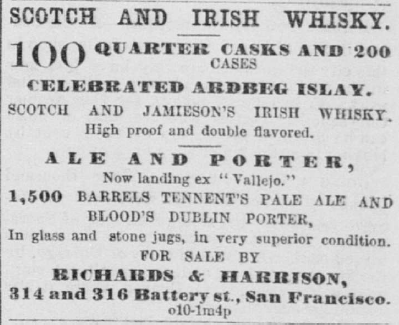
Sacramento Daily Union, November 1871
|
|
While sales of Ardbeg were never large by modern standards, the whisky had clearly found a steady market by the 1880s. It grew much faster after that, when Culbert & Taylor (subsequently W. A. Taylor & Co) became the brand's US agency for The Ardbeg Distillery Company - a company name unknown in the UK but probably created for US market activities.
The Ardbeg Distillery Co joined a stable of well-known firms at Taylor's. The New York firm listed John Jameson & Co, Charles Tanqueray & Co, Gonzales Byass & Co and Martini & Rossi among the companies it represented. C.W. Craig & Co of San Francisco were Taylor's distributors on the West Coast.
|
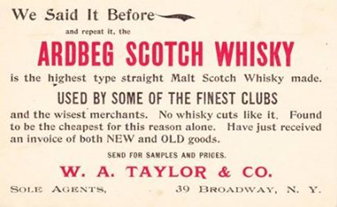
Postcard advert for Ardbeg, c1900. Courtesy
of The Glenmorangie Company Archive.
|
|
Taylor's adverts for Ardbeg were strikingly different from what had gone before - now, rather than referring to it simply as 'Ardbeg', it was advertised for sale by the cask - in octaves or quarters - at different ages; new, one, two or three years old. Bottled Ardbeg was also available, presumably of a greater age at a time when Ardbeg's owners were bottling the whisky at 6-8 years for private customers back home. The different bottled expressions were named 1, 2 and 4 stars, at different prices per dozen.
Taylor's made clear the attractions of the whisky to both the on trade and the wine and spirits merchant. 'Ardbeg Scotch whisky, Islay, [is] an absolute straight malt whisky. This class of whisky contains the least amount of sugar and is harmless to those who suffer from gout and rheumatism. A grand Cutting whisky'. It was 'the highest type of Straight Scotch malt whisky made. Used by some of the finest clubs and the wisest merchants. No whisky cuts like it.'
|
|
Taylor's continued to represent The Ardbeg Distillery Co until the end of the First World War, but we have yet to find adverts for the brand placed by them during the period. There is, however, a series of intriguing notices placed by the Manhattan grocer L.J. Callanan from 1901 until 1910, for Ardbeg he had bottled himself at a variety of ages: the oldest, distilled in 1888 and bottled in 1907, was for sale at $4 a bottle, or $45 for one of the 19 cases in stock.
|
|
Callanan devised several pithy slogans to attract business: Ardbeg was 'the finest Scotch whiskey in New York', and 'the best whiskey for Hot Scotch in America'. He went so far as to propose Ardbeg and Port Ellen for different drinking occasions, when he suggested 'Ardbeg for Hot Scotch, Ramsay's for High Balls'. If there had been Ardbeg Embassies in those days, Callanan's store would surely have been America's first!
|
|
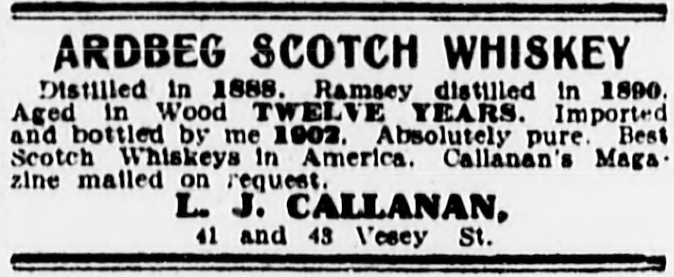
The Sun (NYC) - October 1905
|
|
The surviving records from Ardbeg include correspondence discussing exports to the 'Harrisburg Clubs' in New York (under the brand name 'Shenila'), as well as a growing trade with Canada, Uruguay and Argentina. Exports continued after the outbreak of the First World War, to New York, Boston, San Francisco, Coney Island and Philadelphia. But then came a British Government instruction to close malt whisky distilleries to conserve barley stocks. When they reopened in 1919 the USA itself was closed to business, with the introduction of Prohibition, and Ardbeg exports ceased.
|
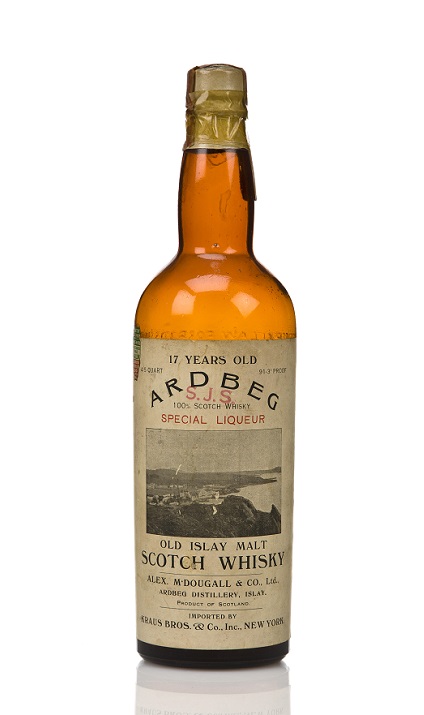 Photo credit: Bonhams.com
Photo credit: Bonhams.com
Kraus Bros bottles
|
|
There was a brief flurry of activity in the late 1930s, when orders were fulfilled for Kraus Brothers & Co in Pennsylvania. The Ardbeg Project's Tim Puett has pointed out that these shipments produced three different bottle variations that are now known to be the oldest verifiable Ardbeg releases to date.
A 1940 advertisement from Weissman's Liquor Store in New York offered a 17-year unblended 'Old Islay Malt' for $4.39 per 4/5 quart. Unfortunately, after the Kraus bottles, Ardbeg practically disappeared from the US market.
1981 marked the return of Ardbeg to the US with the famous dumpy Cadenhead's series. By the 1990s, Gordon & MacPhail, Signatory and Adelphi would join the US invasion, before the revival of the distillery in 1997 and the first US exports by the new owners, Glenmorangie, in 1998.
|
|
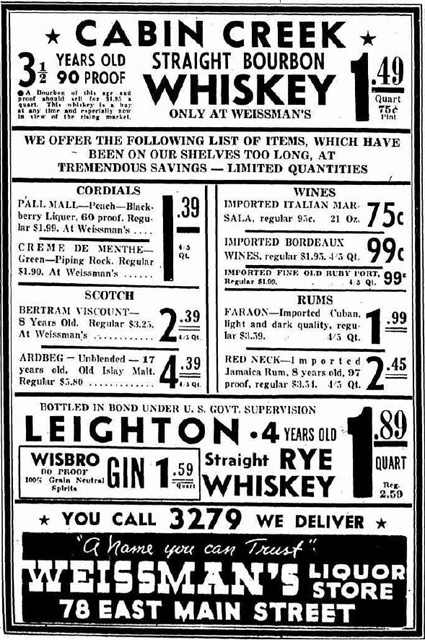
Evening Recorder - May, 1940
Ardbeg Advertisements
|
|
The story of Ardbeg in the USA is just one of many which seem to contradict the hoary old myth, that Americans did not discover single malt Scotch until the 1960s. In fact, there was clearly a small but long-established market for Islays such as Ardbeg and Port Ellen in particular. As happened in the rest of the world, single malts fell out of favour in the USA for much of the 20th century, as the Scotch whisky companies concentrated on marketing blended Scotches, and it took some years before American whisky drinkers rediscovered a taste for peaty single malts like Ardbeg. They've been thirstily making up for lost time ever since...
|
|
|